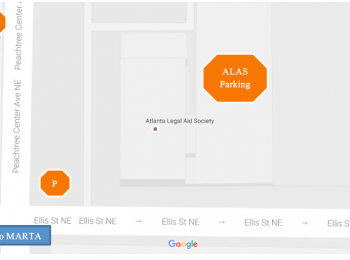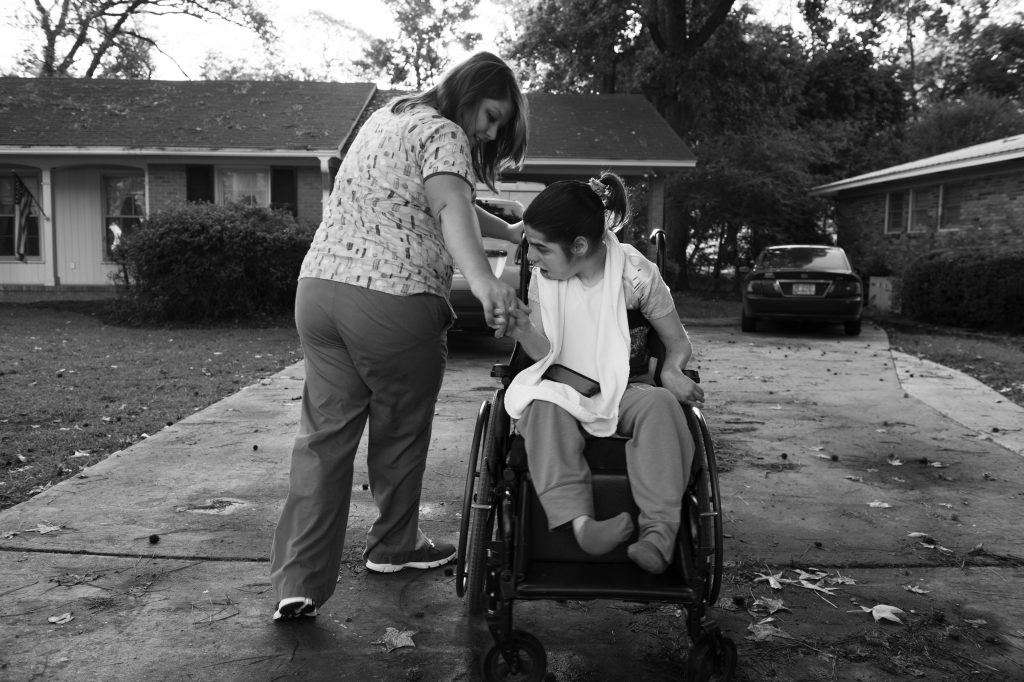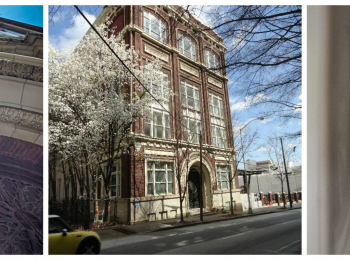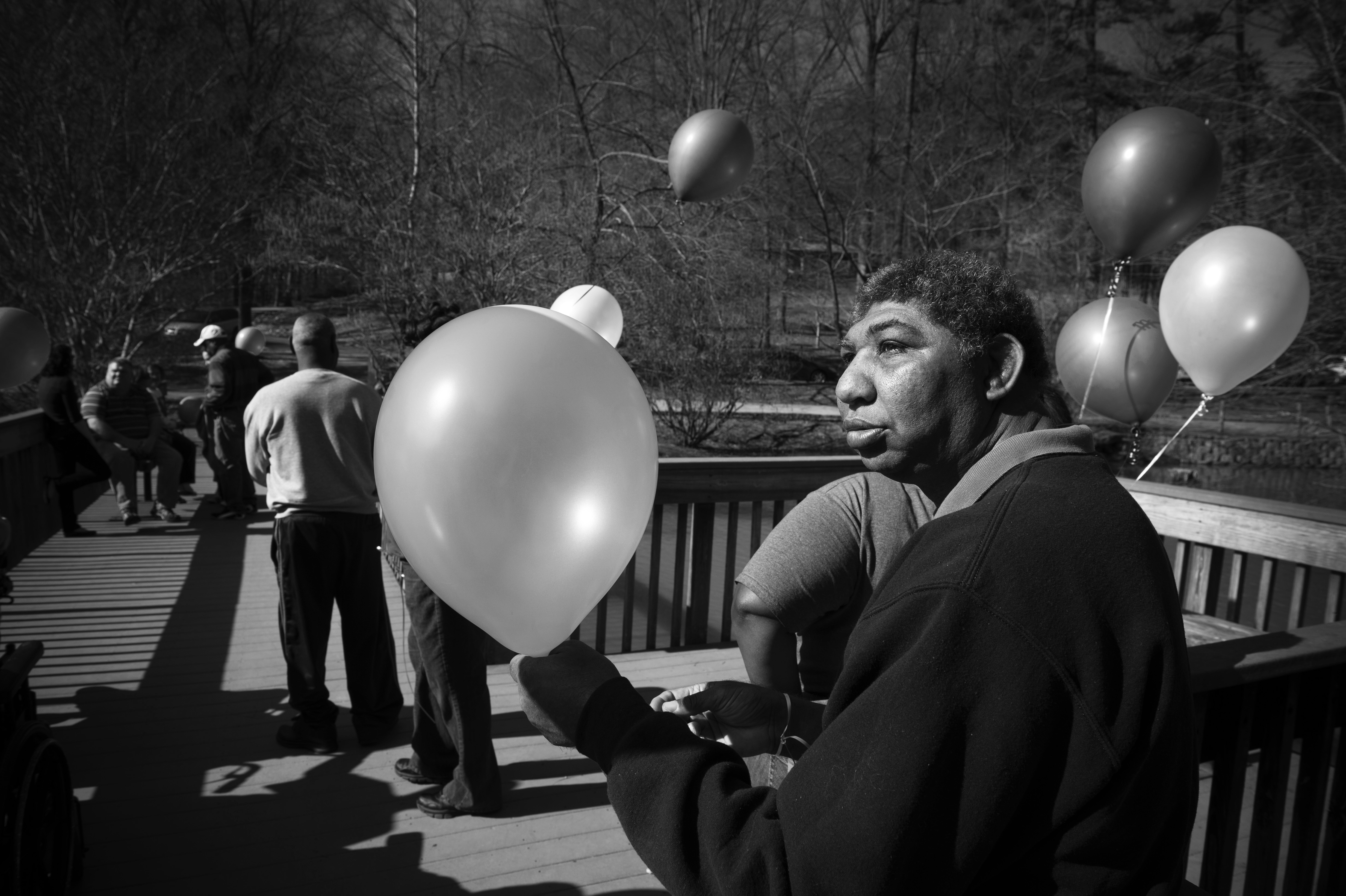
The Photographers

Robin Rayne is an internationally-published magazine and newspaper photojournalist, specializing in disability rights, social justice, human rights and gender diversity and LGBTQ issues. In Robin’s 35-year career, her work has appeared in Newsweek, Time, Business Week, Forbes, New York Times, Wall Street Journal, Los Angeles Times, NBC News, Paris Match and Der Spiegel, among dozens more. Her work is syndicated globally by ZUMA Press photo agency.
Robin also produces documentary films and photo projects for the Institute on Human Development and Disability at the University of Georgia, and frequently speaks to photojournalism classes and photojournalism seminars. Robin is married and lives in Canton, Georgia.
See more on her website.
“These photographs are from a body of work entitled, This Hope is Our Story. The series features portraits of families living in Grove Park, an Atlanta Westside neighborhood experiencing change. Despite the efforts of activists and residents who have been working together to improve the quality of life in the community, suspicion still lingers due to rampant intown development. Gentrification is happening quickly and many Grove Park families are losing their homes and becoming displaced.
I became involved with the Grove Park community through an organization called PAWkids. PAWkids is an after-school enrichment program that provides Grove Park children with various resources that help empower and encourage them, while building stronger communities and developing self-sufficiency. Sadly, PAWkids lost 11 families last year due to gentrification. I am on the board of this organization and it is very important to me that I help tell the Grove Park story through photography. “
See more at: http://www.vjphoto.com/
“Carry the Ocean is the project focusing on Ethiopian immigrants’ communities in Atlanta. It is an exploration into culture difference, communication and shared immigration experience. In the past four years, I went to local Ethiopian families to take their portraits. During each photo sessions, I had the opportunity to learn about Ethiopian culture. This series is as a small window showing a local community who come from a different culture background. It is also a mirror reflecting my understanding of being an immigrant and the idea that immigrants are the fundamental of this country. “
See more at: http://www.shinelightbox.com/
“Spirit Hand is what aboriginal artists call the state of creating and maintaining their cave-works. David was born with a cleft face. The ancient Maya would have seen him as a shaman, a medium of the Spirit Hand, half jaguar and half man, something magical and mysterious. He is not seen, in our society.
Where does human intention, and its consequences, end, and the spirit begin? Maybe there’s not a discrete point, where you can say that there was a change in control…if that’s even the right word. The disabled live invisible lives here. Their struggles are so mundane. They know a special humility, don’t believe in autonomy…self-naming…the way the rest of us do; they have become reconciled to the forces of disorder that touched them, see something we can’t quite perceive.
Do aboriginal artists know when the Spirit Hand is inside them? Or, are they insensate when it passes through their fingers, looks through their eyes, possesses them? Maybe it feels like someone touching your shoulder, but you can’t look around. We think about our own photography, and our work on the processes of scarring and regeneration. It’s a choice, an invocation of sorts, to embrace imperfection, to become part of the work of the Spirit Hand. “
See more at: http://www.mccullersandmontalvo.com/
“Washington D.C.’s latest census recorded over 1,000 youth experiencing homelessness in the district, but experts consider this number to be a severe undercount. Youth often hide their homelessness—they double up unstable accommodations with friends and strangers, avoid traditional shelters and move around often.
“Young and Homeless in Washington D.C.,” a project conducted with the Urban Institute, aims to magnify the personal stories of youth experiencing homelessness. These young people are in the midst of hardship, but they still laugh, love and pursue their dreams Research suggests that dropin centers, tailored to the needs of youth, can provide a low barrier of entry for young people to access formal support. These centers serve as a home base to meet basic needs like a meal or a shower, connect with other youth and build trust with service providers.”
See more at: http://maurafriedman.com/
“In late 2015, I began taking portraits of inmates at the Cook County Jail in Chicago. Working in collaboration with Narratively and the Vera Institute of Justice with support from the John D. and Catherine T. MacArthur Foundation’s Safety and Justice Challenge, I began documenting the prevalence of mental illness among inmates at Cook County Jail in an effort to humanize the reality of mass incarceration in this country, often of its most vulnerable citizens.
The Cook County Department of Corrections is one of the largest single-site pre-detention facilities in the world, with an average daily population hovering around eight thousand inmates. It is estimated that 35 percent of this population is mentally ill.
According to a May 2015 report by the National Alliance on Mental Illness, Illinois cut $113.7 million in funding for mental health services between 2009 and 2012. As a result, two state operated inpatient facilities and six City of Chicago mental health clinics have shut down since 2009. Emergency room visits for patients having a psychiatric crisis increased by 19 percent from 2009 to 2012, and a 2013 report by Thresholds found that the increase in ER visits and hospitalizations resulting from the budget cuts cost Illinois $131 million—almost $18 million more than the original “savings.”
In addition, Illinois Governor Bruce Rauner’s refusal to pass a budget for more than two years has caused more than eighty thousand people in Illinois to lose access to mental health care.
Two-thirds of nonprofit mental health care agencies in Illinois have reduced or eliminated programs, and a third of Chicago’s mental health organizations have had to reduce the number of people they serve. The Cook County Sheriff’s Office estimates that it costs $143 per day to house a general population inmate. But when taking into account the treatment, medication, and security required to incarcerate a mentally ill person, the daily cost doubles or even triples—yet now more patients than ever are being treated in jail rather than at a mental health facility. Cook County Jail has become one of the largest, if not the largest, mental health care provider in the United States.”
“Denise was diagnosed with Alzheimer’s disease in 2012 at the age of 56. I followed Dan & Denise for a day in 2016 to highlight the toll Alzheimer’s had taken on their lives. At this point in time Denise was still living at home, but the disease had impacted every single aspect of their day, from the minute details to recognition of close family members. Currently, an estimated 5.8 million Americans live with Alzheimer’s disease. There are no effective treatments and no cure.”
Kirti Fatania-Bassendine cultivated an interest in photography from a young age. Her artistic expression was shaped by her experiences growing up in a minority culture in England. She graduated with BA Honors in Fine Art Photography from Derby University, England. Following several exhibitions focusing on cultural identity that toured the United Kingdom, she settled in the United States and spent 25+ years combining professional photography with fine art projects. Over the last six years, her artwork has focused on cultural storytelling through still photography and videography. As an artist she has always been intrigued by human relationships and how they interweave within social and cultural contexts – especially women’s sense of identity and belonging within their culture and the wider world; how homelessness and nomadic ways of life are perceived; and how its subcultures integrate or conflict with modern society.
Find more at: https://kirtibassendine.com/gallery/homeless-voices
“I’ve had the honor of working closely with the Office of the Fulton County District Attorney since 2017, mostly capturing activities through the eyes of their Community Prosecution model, which physically brings the Office of the District Attorney into the actual neighborhoods they serve via staffed outposts. The Legal Lives Competition is one of the Office’s signature programs, introducing young people to careers in the legal field by developing a hands-on understanding of how the court system works. Adopting a model developed by the Kings County District Attorney’s Office in Brooklyn, New York, the Office of the Fulton County District Attorney Legal Lives Competition is a 15- week instructional program led by volunteer prosecutors who teach 5th grade students lessons on civics and criminal law. At the end of the course, students compete in a mock trial competition in which students perform as judges, lawyers, witnesses and law enforcement officers in the student adaptation of a real-life theft case. I believe that if we are to empower individuals and communities as it relates to the criminal justice system, and possibly solve some of the inherent issues in said system, educating the youth through safe and enjoyable engagement such as this is a wonderful place to start. These images are from the 2019 competition.”
Find more at: http://www.pixelegant.com/
How does a city learn from its past mistakes if that city willfully ignores its mistakes? Thirty years ago, a black working class neighborhood called Lightning was demolished in order to make way for the Georgia Dome. In front of the Mercedes-Benz Stadium, a historic marker for the Georgia Dome was placed where it once stood. The marker extolls the economic virtues of of the dome and the numerous championships that were played there, yet nowhere on the marker is the community of Lightning mentioned. Today, the history of Lightning exists mostly in the memories of those who called it home. These portraits originally appeared in The Bitter Southerner article, “Lightning, Struck,” an oral history conducted by reporter Max Blau. As Atlanta continues to develop at a break-neck pace, it is critical that we create space to remember what we’ve thrown away to get here.
Link to oral history: https://bittersoutherner.com/lightning-the-atlanta-community-lost-to-super-bowl-dreams
Find more at: http://www.dustinthomaschambers.com/
Our Partners
Atlanta Celebrates Photography
Atlanta Celebrates Photography (ACP) is a non-profit arts organization dedicated to the cultivation of the photographic arts and the enrichment of the Atlanta art community.
Atlanta Celebrates Photography (ACP) aims to make Atlanta a leading center for the world’s fastest growing art form. Primarily, by producing the largest annual community-oriented photo festival in the United States, we provide experiences that engage and educate diverse audiences through lens-based media.
ACP hosts an annual, citywide photography festival in October: the Atlanta Celebrates Photography Festival. The festival includes a wide variety of exhibitions and multiple events around Atlanta and throughout the surrounding communities. The festival’s diverse offerings bring together professional and amateur photographers, general art enthusiasts, gallery owners, critics, and collectors.
Throughout the year, ACP sponsors additional community programming and opportunities specifically for the professional development of photographers. Get involved with ACP to find out how you can contribute and participate!
Learn More



